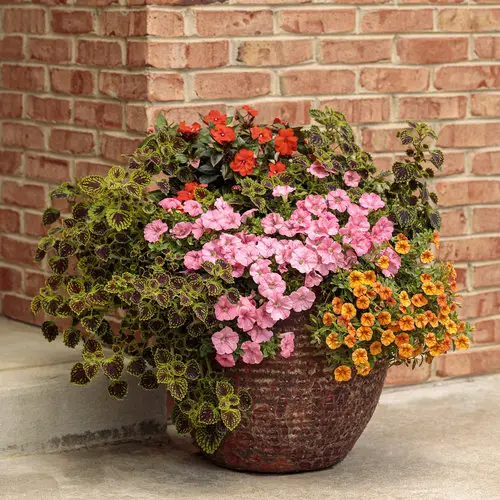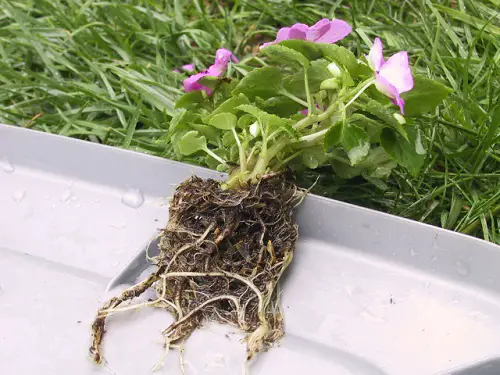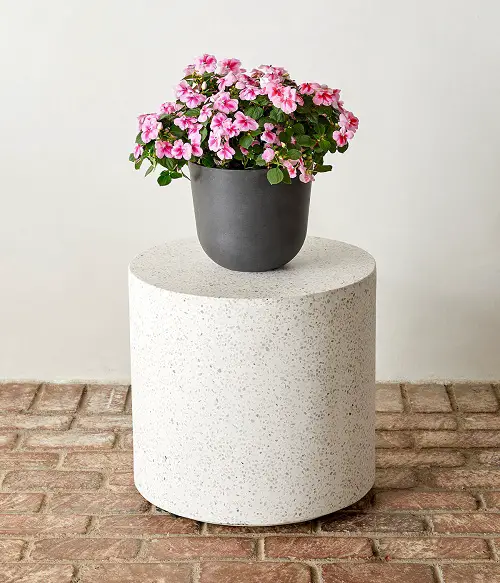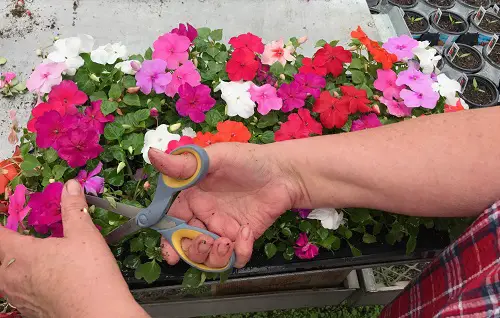If you want to know Everything About Growing Sunpatiens, we have all the info here! Check out our Sunpatiens Care Guide!

Knowing Everything About Growing Sunpatiens is easy as long as you provide the plant with sunlight in abundance. For everything else, our Sunpatiens Care Guide will help you!
Botanical Name: Impatiens x hybrida SunPatiens
Bloom Time: Spring, Summer, and Fall
Flower Colors: Red, Orange, Purple, Pink, White
USDA Zones: 9-12
Take a look at the Variegated Impatiens Varieties
Sunpatiens information
Sunpatiens are a type of flowering plant that is native to tropical and subtropical regions of the world. They are a hybrid of two types of wild impatiens, Impatiens hawkeri, and Impatiens niamniamensis.
Sunpatiens are known for their vibrant colors, hardiness, and long-lasting blooms. They are ideal for garden beds, containers, and hanging baskets, as they can tolerate a wide range of growing conditions and do not require much maintenance.
Best Sunpatiens Varieties to Grow

- Sunpatiens Compact Orange: This compact variety produces vibrant orange blooms that will bloom from spring until fall.
- Sunpatiens Compact Pink: This variety produces beautiful pink blooms that can be enjoyed from spring to summer.
- Sunpatiens Vigorous White: This variety produces large white blooms and is ideal for creating a beautiful contrast against other bright-colored flowers.
- Sunpatiens Compact Red: This variety produces bright red blooms and will give your garden a pop of color.
- Sunpatiens Vigorous Pink: This variety produces large, hot pink blooms that will add a fun and cheerful touch to your garden.
Look at the Impatiens Varieties
Best Pot Size for Sunpatiens
You can start the plant in a 6-8 inches pot. When selecting a pot size, consider the size and growth rate of the variety you are growing. Depending on the growth and spread of the plan, keep on re-potting it in a one-size bigger container.
Propagating Sunpatiens

- To propagate Sunpatiens, first, choose a healthy stem of the plant that has at least two sets of leaves.
- Cut the stem just below the bottom set of leaves and remove the lower leaves.
- Dip the cutting in the rooting hormone and stick it in moist soil or a potting mix.
- Place the pot in a warm, bright location and keep the soil moist.
- The new plant will form roots in about two weeks.
Requirements to Grow Sunpatiens

Sunlight
Sunpatiens are a type of flower that thrives in full sun, meaning that they should receive at least six hours of direct sunlight per day.
While they can tolerate some shade, the flowers will be healthier and more vibrant in full sun. Plant them in a sunny spot in your garden and enjoy the beautiful blooms!
Soil
These plants thrive in a well-draining and nutrient-rich soil that is slightly acidic (pH 6.5-7.0). The growing medium should contain plenty of organic matter, such as compost, to improve fertility and water retention.
Sunpatiens prefer light to medium soils, so a soil mix that contains a combination of sand, loam, and peat moss is ideal.
Watering
The best way to water Sunpatiens is to soak the soil thoroughly, allowing the water to reach the roots. This can be done by using a soaker hose or by hand-watering with a watering can.
Be sure to water in the morning and avoid getting the leaves wet. Watering once or twice a week should be enough to keep your Sunpatiens happy, although they may need more depending on the temperature and humidity.
Note: If the soil feels dry to the touch, it’s time to water.
Temperature and Humidity
Sunpatiens thrive best in a hot and humid climate. The temperature range of 60-66°F or 15-19°C is ideal for young plants to establish their root system. Once established, the best range is 65-85°F or 18-35°C during the day and 60-66°F or 15-19°C at night.
Note: Ensure to maintain the humidity level between 40-70 percent by keeping its pot on a pebble tray filled with water to prevent diseases like myrothecium or botrytis.
Sunpatiens Care

Fertilizing
These plants prefer a balanced fertilizer with a ratio of 10-10-10 or similar. Fertilize once in 2-3 weeks during the growing season with a water-soluble fertilizer diluted to 1/2 of its recommended strength.
For container-grown plants, use a liquid fertilizer and water it into the soil. Avoid getting fertilizer on the leaves, as this can cause leaf burn.
Pruning
Although these plants generally don’t require any pruning, doing so can help keep the plants looking neat and compact.
Prune Sunpatiens back to the desired height and shape in the late spring or early summer when the weather is warm.
Cut any spindly or leggy stems back to the base, as well as any dead or damaged stems and foliage. This will help promote healthy new growth and encourage the plant to produce more flowers.
Pests and Diseases
Sunpatiens are generally very tolerant of pests and diseases. However, they are still susceptible to some. Common pests include aphids, thrips, spider mites, mealybugs, whiteflies, and caterpillars. Diseases that may affect Sunpatiens include powdery mildew, leaf spot, bacterial wilt, and root rot.
To prevent or control pests and diseases, practice good garden hygiene by removing dead or damaged leaves and stems. Also, regularly check for signs of infestation.
Try to avoid overcrowding the plants and keep the foliage dry to reduce the chance of fungal or bacterial diseases. If needed, use an appropriate insecticidal or fungicidal spray or dust to treat infestations.
Check out Flowers That Look Like Impatiens
Sunpatiens vs Impatiens
Sunpatiens and impatiens are both members of the Impatiens family. Sunpatiens are a cultivar of the New Guinea impatiens, which is a type of impatiens that is more tolerant of full sun.
- Sunpatiens are a good choice for sunny spots in the garden, whereas impatiens prefer more shade.
- They are more vigorous plants than traditional impatiens, and they come in a wider range of colors. They also require less maintenance than traditional impatiens and are more disease-resistant.



My sun patients have white covering on stem, tiny flying things and leaves turning yellow with spots. What pests are these and how can I cure this?